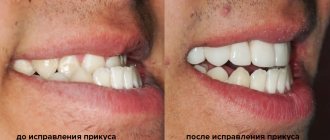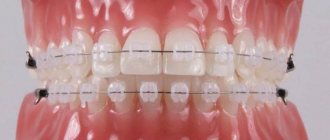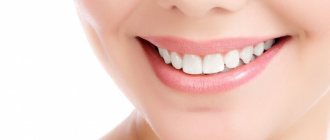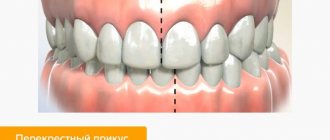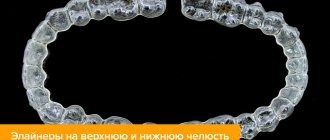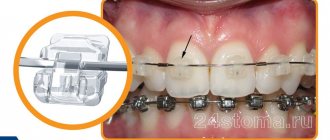Bite correction using braces or other orthodontic products is already a common treatment method. But no matter how effective braces are, they are not always able to cope with pathologies of the dental system. In difficult cases, it is necessary to resort to surgical correction of the bite. The cost of such treatment depends on the indications and features of the operation. How much the surgery to correct the bite costs is determined by the maxillofacial surgeon individually. On average, treatment costs 250,000–300,000 rubles.
When is surgery needed for bite problems?
Specialists resort to surgical intervention when conventional orthodontic treatment methods have failed.
- Wearing permanent braces.
- Treatment with aligners.
- Installation of trainers (the method is suitable for children).
- Installation of veneers (used in mild cases of malocclusion).
- Laser bite correction.
Braces or removable aligners (teeth aligners) in most cases cope with the problem. However, with significant skeletal deformations, which are expressed in the disproportionate size of the jaws, their improper closure, and deformation of the chin, these methods are powerless.
Complex bite pathologies, for example significant closure defects, cannot be treated by wearing orthodontic structures for a long time. Orthodontists do not always take this fact into account. Meanwhile, focusing only on orthodontic treatment can have significant negative consequences for the patient: tooth dislocations or pathologies of the temporomandibular joint are quite possible in this case. And they bring with them completely different problems: pain in the head and back, disorders of the gastrointestinal tract and other diseases that at first glance are difficult to associate with malocclusion pathologies.
Types of occlusion defects and methods of their correction
Scientists have calculated that only 40% of the planet's inhabitants are the happy owners of an ideal bite. All others have deviations from the norm to one degree or another. Defects can be critical when they have a negative impact on human health, and practically unnoticeable, not leading to moral or physical discomfort.
The picture below shows occlusion anomalies:
Modern orthodontics includes several methods for correcting malocclusion:
- using braces;
- through surgery;
- using myotherapy (physical exercises) and non-braces corrective devices.
Orthognathic surgery: what is it?
This is a surgical correction of the bite. During the operation, not only the bite is corrected, but also externally noticeable facial asymmetry: the surgeon shortens or lengthens the jaw, corrects its location, and changes the size of the chin. At the same time, along with the bone structure, soft tissues are also transformed. Therefore, a person’s appearance changes for the better.
Mouth guards
Mouthguards, or aligners, are removable plastic or silicone transparent covers on the teeth. Made individually for a specific patient. They are worn constantly and are removed only for eating and hygiene procedures.
They are practically invisible, so they do not cause moral discomfort. The therapeutic effect is determined by a soft force effect on the dental elements, causing them to move in a given direction. The main disadvantage is the inability to eliminate particularly complex defects.
Important: the effectiveness of mouth guards for correcting malocclusion depends not only on the severity of the clinical case, but also on strict self-discipline. Failure to comply with the orthodontist's instructions will negate all efforts made.
When orthognathic surgery is contraindicated
Surgeons will not undertake such an operation if the jaws have not yet formed - in adolescents and children. We also highlight such contraindications as:
- cardiovascular diseases;
- problems with blood clotting;
- the presence of precancerous and cancerous diseases;
- diseases of the endocrine or skeletal system;
- diabetes in some stages;
- disorders associated with mental state.
Specialists will most likely refuse those patients who think that this operation can improve their appearance, even without problems with their bite. With all the possibilities of orthognathic surgery to rejuvenate the patient and improve his appearance, it primarily solves serious problems with bite and should not be perceived as a beauty procedure.
Records
Vestibular plates are removable orthodontic devices. This means that they can be removed for a while, for example, to eat or brush your teeth. The plate for correcting pathologies is made individually for each patient using personal casts of the jaws.
The base of the plate is a plastic base that is adjacent to the palate. Arcs, clasps and screws are integrated into it. The base color can be neutral or colored.
These devices are mainly used in childhood and adolescence, when the dental system is not yet fully formed and therefore the dental elements are able to move relatively easily under the influence of directed force. The plates are also used to correct pathologies in adult patients, but only in mild cases.
Can complications occur after orthognathic surgery?
The result of this surgical intervention is completely predictable, so complications after surgery in most cases should not occur. There may be temporary numbness of the lips. However, in the postoperative period this is acceptable and even helps the patient avoid pain. When the previous sensitivity of the lips returns, there is no more pain.
You can insure yourself against the negative consequences of surgery if you seek help from reliable specialists.
Etiology
Factors predisposing to the formation of a deep bite are hidden in the prenatal period. Hereditary predisposition, infectious diseases suffered during pregnancy, mechanical injuries and chronic diseases (for example, anemia) can cause such negative consequences.
Causes of deep bite:
- Prenatal: toxicosis,
- intrauterine infectious diseases,
- multiple pregnancy,
- reduced oxygen content in the body.
- protein-energy malnutrition,
- late teething,
Do I need to prepare for orthognathic surgery?
The preparatory period can last more than one week. As mentioned above, orthognathic surgery is completely predictable. Therefore, at the first stage, the specialist decides what results should be after treatment:
✔
determines the necessary future parameters;
✔
finds the maximum possible number of closures between opposing teeth;
✔
monitors how the results of the operation will affect the patient’s appearance.
In most cases, when preparing for surgery, surgeons use special 3D modeling tools for the result. Thanks to the software, a template is obtained and the paths that will lead to the expected effect of orthognathic treatment are found.
Then orthodontic treatment with braces or aligners begins. This can take from several months to a year and a half. Once the dentition is aligned, orthognathic surgery can begin.
Orthognathic intervention takes 4-6 hours. Then the patient remains in the clinic for another 3-4 days under the supervision of the attending physician. Afterwards you can return home, and after 3 weeks you can go back to work.
Patient Reminder
- Patients who have suffered an acute viral infection 10-14 days before the procedure are not allowed to undergo surgery. Any ailment (high blood pressure, temperature, gastrointestinal disorders, sore throat) requires rescheduling surgery;
- on the eve of hospitalization (10-12 hours) it is recommended to refrain from drinking alcoholic beverages and smoking;
- before surgery, taking liquids/food is strictly prohibited;
- You should wash off your makeup, remove dentures, jewelry, and contact lenses;
- The doctor must be aware of existing allergies to medications and routine medications taken.
The duration of the procedure depends on the volume and complexity: correction of defects on both jaws takes 4-4.5 hours, on one jaw - 1-1.5 hours, correction of the chin - 6-6.5 hours. Jaw fusion occurs in 2-4 months, wound healing in 10-14 days.
How is surgical correction of bite performed?
There are 3 main types of orthognathic operations:
- maxillary osteotomy - the surgeon makes bone cuts in the mouth above the teeth and below the eye sockets to realign the upper jaw, including the palate and upper row of teeth. The jaw is fixed using a special splint, which will securely fix it in the correct position in relation to the soft tissues,
- osteotomy of the lower jaw - the doctor makes bone incisions behind the molars along the jaw downwards and, using a titanium plate, moves the lower jaw to a new place,
- Genioplasty is necessary when aligning the midline of the patient’s face, which runs between the two upper front incisors. With this method, the surgeon cuts off the chin part of the lower jaw and moves it to the correct position.
They do not leave scars on the face, because... performed inside the oral cavity. They are performed after 18 years of age, when jaw growth is completed, only under general anesthesia and for 1-6 hours.
Classic vestibular braces
They are also external braces - the most common. These braces are fixed on the outer surface of the teeth, the one we see when we smile.
Vestibular braces are the most popular system for correcting malocclusion, but they are not the only one, including for adults.
Ligature braces (the arch is secured with special rubber bands - ligatures)
Advantages of external braces in the treatment of malocclusion:
- This is the most functional device that we can use in adults. Corrects all possible malocclusions. If the case is complex and surgery is needed, braces are worn before or after it. In addition, they can be supplemented: install springs, rods, buttons, ligatures, chains for pulling out impacted teeth. The more complex the pathology, the greater the likelihood that something additional will need to be tightened, and this is where such a wide functionality of braces comes in handy.
Example: a spring connects the braces and forms the bite
- The second plus is a consequence of the first: braces provide the maximum effect of expanding the dentition. If the row is significantly narrowed compared to the norm, braces are most preferable. In addition, the narrowing of the dentition is most often accompanied by the absence of some teeth (that is, they are there, but are located inside the gums - they remain impacted). And pulling out impacted teeth using an arch of braces is justified and convenient.
- Price. You can choose to suit any budget. Expensive - transparent sapphire and for a relatively small amount - metal. Visually they are less attractive, but no worse in efficiency.
Aesthetic ceramic braces are less noticeable.
External braces also have disadvantages. Moreover, they are the same for any system, both the simplest metal one and the aesthetic one with white or transparent braces.
- Any external braces, even white-painted arches, are still noticeable. And this often influences the choice: not all adults are ready to wear them. Although no one is surprised by braces for a long time, and no one pays attention to them, for many it is still a psychological barrier.
- It is more difficult to maintain hygiene. Although adult patients usually take a conscious approach to treatment and follow all recommendations, force majeure nevertheless occurs: trips on vacation or a business trip, where there is no time or it is inconvenient to constantly brush your teeth after eating. Braces are a non-removable structure, you have to eat with them, and leftover food remains on them. You have to spend about 20 minutes on each brushing (about an hour a day in total), otherwise plaque will form, which increases the risk of developing caries. Braces themselves do not cause caries and do not spoil the enamel - plaque damage due to poor hygiene does.
- Wearing braces hurts. Although this is subjective, it all depends on the individual and pain threshold. In the first days after activation of the system (it is carried out every month), some patients sometimes have to take pain medication. In addition, the protruding parts of the braces can scratch the oral mucosa and rub it. For most patients, this goes away within a few days, while others experience discomfort from such side effects throughout the entire treatment period. But you can seal the protruding areas of the braces with orthodontic wax.
This is what braces with protective wax look like
- You are not allowed to eat all foods with braces, even after the pain subsides. Avoid solid foods - hard fruits and vegetables, nuts. Chewing meat also becomes difficult, as fibers become clogged in the space between the teeth and the arch. The fact that you will have to eat food pureed through a blender for a year is an exaggeration, but you can forget about some delicacies for a year and a half.
Braces are effective for treating adults, but you have to come to terms with the shortcomings of this technology. Spend a lot of time taking care of your teeth, limit yourself to certain dishes, get used to your smile with “decoration”.
What to do in the postoperative period
In addition to following all the instructions of the attending physician, you need to pay attention to several important points.
- You need to apply ice to the jaw area and apply ointment or gel for swelling.
- Strictly observe daily routine and hygiene: get up, walk around, do not smoke, eat.
- Avoid heavy objects, do not bend over, avoid sudden movements.
- Do not hesitate to seek help if there is any discomfort.
The second most popular question concerns nutrition during the postoperative period. Contrary to expectations, the straw does not always help. According to reviews from people who have undergone this operation, it is better to use a small spoon. The only difficulty with eating usually is that it takes longer. In the hospital, during the postoperative period, patients are prescribed a gentle diet, in which dishes are served pureed.
Immediately after returning home, you can choose your usual menu, guided by your preferences. However, at first, the food should still be pureed. If necessary, you can consult a gastroenterologist.
Uneven position of teeth and exposure of cervical areas of teeth
Before
Stages
After
In addition to the uneven position of the teeth, the patient’s main complaint was the exposure of the cervical areas of the teeth, the appearance of wedge-shaped defects and, as a result, increased sensitivity. Such nuances appear when the dental system is overloaded due to the lack of correct functional guidance (lack of normal position of the canine, in particular, on the right side). And also in case of incorrect position of the teeth relative to the bone tissue of the jaw.
Based on the results of orthodontic treatment after 18 months, under the control of a computer tomogram, we corrected the position of the roots relative to the bone tissue of the jaws and built a correct occlusal scheme, where the teeth do not experience overload. This work made it possible to reduce the severity of previously existing recessions.
What is the cost of orthognathic surgery?
An accurate calculation of the cost of surgical intervention can only be done individually after consultation with an orthodontist and a surgeon in the clinic of your choice. Plus, you will always additionally need to take a panoramic image or computed tomography of the maxillofacial region, condylography. In addition, correcting the bite may require the participation of related specialists.
When searching for a suitable dentist, pay attention to the clinic’s special offers: in some cases, you may be offered to pay for services in installments or in parts.
Indications
- open lateral bite. It is characterized by the presence of a gap between the jaws: the face becomes asymmetrical, the functioning of the facial muscles is disrupted, and the risk of damage to the mandibular joint increases. The patient is unable to chew food or swallow/breathe normally;
- incorrect frontal closure. Provokes disruption of the chewing process, distorts diction;
- chin dysplasia. With this pathology, the configuration and shape of the chin are greatly changed, as a result of which the appearance deteriorates and problems arise with closing the lips and diction.
Contraindications
: age under 18 years, diabetes 2-3 degrees, diseases of the blood, heart muscle, blood vessels, individual intolerance to anesthesia, oncology.
